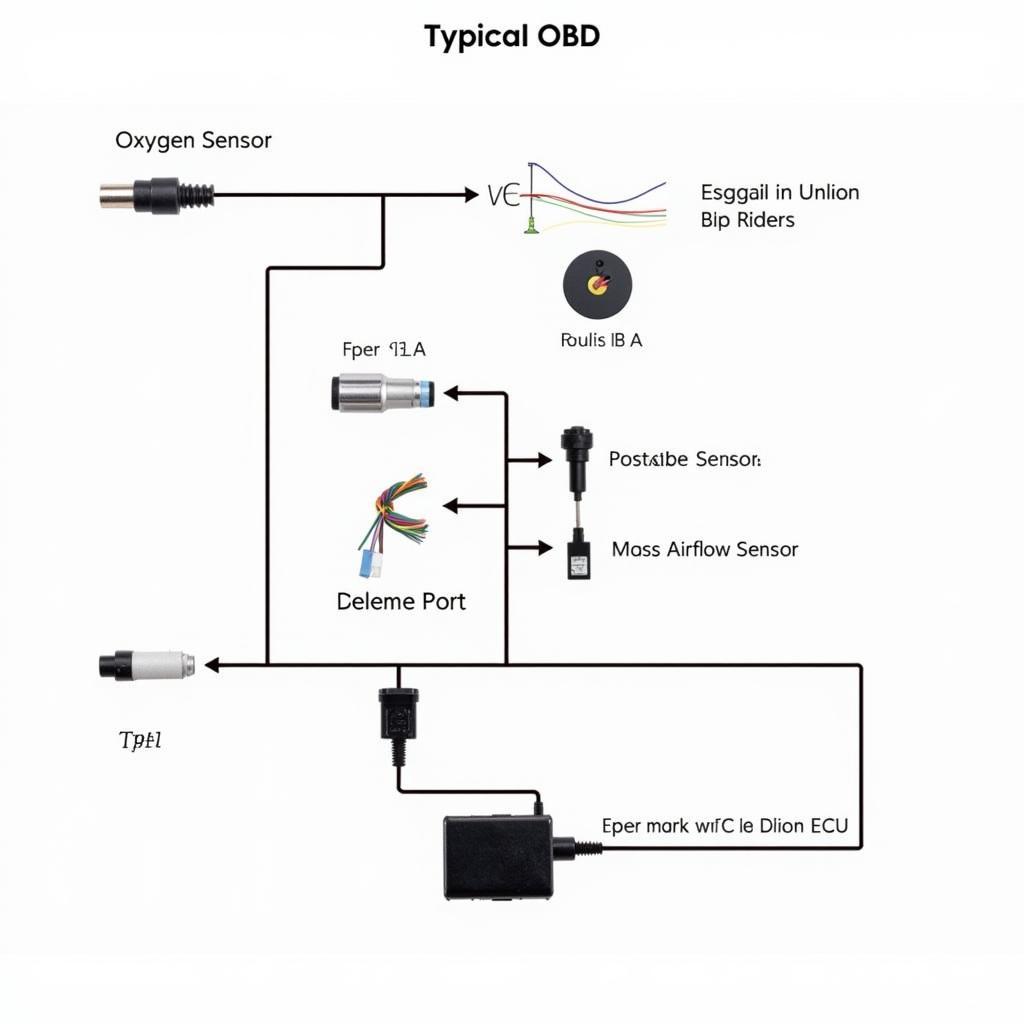Have you ever seen a mechanic plug a mysterious device into your car’s dashboard and wondered what it was? That’s an OBD2 scanner, and it’s the key to understanding what’s going on under the hood. This comprehensive guide delves into the world of OBD and OBD2, exploring their purpose, evolution, and impact on the automotive industry.
Demystifying On-Board Diagnostics (OBD)
OBD, or On-Board Diagnostics, is essentially your car’s self-diagnostic system. It comprises sensors strategically placed throughout the engine and other crucial components. These sensors constantly monitor parameters like engine speed, temperature, oxygen levels, and emissions. When a sensor detects a reading outside the predefined acceptable range, it triggers a warning light on your dashboard, such as the “Check Engine” light.
The Evolution to OBD2: A Standardized Approach
Before OBD2, car manufacturers had their own proprietary diagnostic systems and connectors. This lack of standardization made it challenging for mechanics to diagnose issues across different car makes and models.
In 1996, the OBD2 standard was introduced in the United States, revolutionizing vehicle diagnostics. OBD2 mandated a standardized 16-pin connector, a universal set of diagnostic trouble codes (DTCs), and a common communication protocol. This standardization made it possible for any OBD2 scanner to communicate with any OBD2-compliant vehicle, regardless of the make or model.
What Does OBD2 Tell You?
OBD2 provides a wealth of information about your vehicle’s health and performance. By connecting an OBD2 scanner, you can access:
- Diagnostic Trouble Codes (DTCs): These codes pinpoint specific areas within the vehicle’s systems that are experiencing issues.
- Freeze Frame Data: This snapshot captures the engine’s operating conditions at the time a fault code was stored.
- Live Data Stream: This real-time data feed displays various engine parameters, enabling you to monitor performance and identify potential problems.
Benefits of OBD2 for Car Owners
OBD2 empowers car owners in several ways:
- Early Problem Detection: Identifying issues early on can prevent costly repairs down the line.
- Informed Repair Decisions: Understanding the DTCs helps you discuss potential repairs with your mechanic more effectively.
- Improved Fuel Efficiency: Monitoring engine performance can help you optimize fuel consumption.
- Enhanced Vehicle Control: Some OBD2 scanners offer features like performance tracking and customization options.
OBD2 Scanners: Your Gateway to Vehicle Insights
An OBD2 scanner acts as the interface between your vehicle’s computer and you. It retrieves and decodes the data from the OBD2 system, presenting it in a user-friendly format.
There are various types of OBD2 scanners available, from basic code readers to advanced professional-grade tools. You can find scanners that connect to your smartphone or dedicated handheld devices with built-in displays.
For example, if you’re interested in delving deeper into specific vehicle models, you can explore resources like our 1996 Toyota Camry OBD2 calculator.
Common OBD2 Myths Debunked
Myth 1: OBD2 Scanners Can Fix Car Problems
OBD2 scanners are diagnostic tools, not magical repair wands. They help identify issues but don’t fix them.
Myth 2: All OBD2 Scanners Are Created Equal
Different scanners offer varying levels of functionality and features. Choose a scanner that aligns with your needs and technical expertise.
Myth 3: OBD2 is Only for Mechanics
OBD2 is accessible to anyone interested in understanding and monitoring their vehicle’s health.
The Future of OBD: Embracing Connectivity
OBD technology continues to evolve with advancements in vehicle connectivity and data analytics. Emerging trends include:
- Remote Diagnostics: Accessing vehicle diagnostic information remotely through telematics systems.
- Predictive Maintenance: Utilizing data analysis to anticipate potential vehicle issues before they arise.
- Integration with Smart Cities: OBD data contributing to traffic management and environmental monitoring initiatives.
Conclusion
Understanding OBD and OBD2 empowers you to take control of your vehicle’s maintenance and make informed decisions about its care. Whether you’re a car enthusiast or simply want to be a more informed car owner, OBD2 scanners provide invaluable insights into the health and performance of your vehicle.
FAQs About OBD and OBD2
1. Is my car OBD2 compliant?
Most vehicles manufactured in the United States after 1996 are OBD2 compliant. You can check your owner’s manual or look for a 16-pin diagnostic connector under the dashboard.
2. Can I install an OBD2 port in an older car?
While possible, it requires extensive modifications and may not be cost-effective.
3. What does it mean when my check engine light is flashing?
A flashing check engine light indicates a potentially serious issue requiring immediate attention.
4. How often should I use an OBD2 scanner?
It’s a good practice to scan your vehicle for codes periodically, especially if you notice any unusual performance issues.
5. Can an OBD2 scanner tell me why my ABS light is on?
Not all OBD2 scanners can access ABS-related codes. You might need a more advanced scanner or consult a mechanic.
For more information on specific OBD2 codes and troubleshooting, check out our other informative articles like this one on OBD2 long fuel trim. If you’re experiencing a ‘scan link failure,’ this article on OBD2 scan link failure could be helpful.
Need help with a specific OBD2 code like DL972? Visit our page dedicated to DL972 OBD2 for detailed insights.
Looking for reliable prise obd2 Bluetooth? We can help you make the right choice.
Remember, knowledge is power when it comes to car maintenance. Arm yourself with an OBD2 scanner and explore the world of on-board diagnostics.
If you need further assistance, our dedicated team is available 24/7 via WhatsApp: +1(641)206-8880 or Email: [email protected]. We are here to help you navigate the world of OBD2 with confidence.

